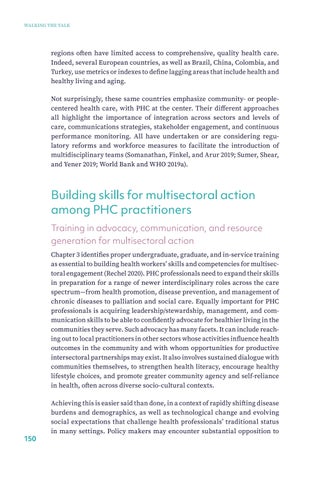WALKING THE TALK
regions often have limited access to comprehensive, quality health care. Indeed, several European countries, as well as Brazil, China, Colombia, and Turkey, use metrics or indexes to define lagging areas that include health and healthy living and aging. Not surprisingly, these same countries emphasize community- or people- centered health care, with PHC at the center. Their different approaches all highlight the importance of integration across sectors and levels of care, communications strategies, stakeholder engagement, and continuous performance monitoring. All have undertaken or are considering regulatory reforms and workforce measures to facilitate the introduction of multidisciplinary teams (Somanathan, Finkel, and Arur 2019; Sumer, Shear, and Yener 2019; World Bank and WHO 2019a).
Building skills for multisectoral action among PHC practitioners Training in advocacy, communication, and resource generation for multisectoral action Chapter 3 identifies proper undergraduate, graduate, and in-service training as essential to building health workers’ skills and competencies for multisectoral engagement (Rechel 2020). PHC professionals need to expand their skills in preparation for a range of newer interdisciplinary roles across the care spectrum—from health promotion, disease prevention, and management of chronic diseases to palliation and social care. Equally important for PHC professionals is acquiring leadership/stewardship, management, and communication skills to be able to confidently advocate for healthier living in the communities they serve. Such advocacy has many facets. It can include reaching out to local practitioners in other sectors whose activities influence health outcomes in the community and with whom opportunities for productive intersectoral partnerships may exist. It also involves sustained dialogue with communities themselves, to strengthen health literacy, encourage healthy lifestyle choices, and promote greater community agency and self-reliance in health, often across diverse socio-cultural contexts.
150
Achieving this is easier said than done, in a context of rapidly shifting disease burdens and demographics, as well as technological change and evolving social expectations that challenge health professionals’ traditional status in many settings. Policy makers may encounter substantial opposition to
